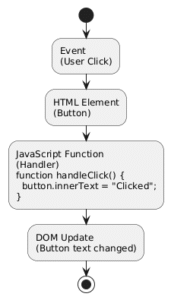Document Object Model (DOM): Interacting with Web Pages
The Document Object Model (DOM) is a programming interface for HTML and XML documents. It represents the page so that programs can change the document structure, style, and content. Essentially, the DOM provides a structured representation of the document, treating every element, attribute, and piece of text as an object that JavaScript can access and manipulate. By leveraging the DOM, web developers can create highly interactive and dynamic web pages that respond to user actions and display updated information without requiring a full page reload.
What is the Document Object Model (DOM)?
The Document Object Model (often simply referred to as the DOM) is a cross-platform and language-independent API that connects web pages to scripting languages like JavaScript. When an HTML document loads in a web browser, the browser creates a tree-like structure, or a “node tree,” that represents the entire document. Every part of the HTML document—such as elements (<html>, <body>, <p>), attributes (id, class), and text—becomes a node in this tree. Consequently, JavaScript can then interact with these nodes to modify the web page.
The Document Object: The Root of the DOM
At the very top of the DOM tree is the document object. This object represents the entire HTML document and serves as the primary entry point for all manipulations of the web page. When an HTML document is loaded into the browser, it transforms into this document object. From this root, you can access all other elements and nodes within the document. Therefore, the document object is fundamental for beginning any interaction with the Document Object Model.
Essential DOM Properties for Manipulation
The document object, along with individual HTML element objects, exposes various properties that JavaScript can use to retrieve or modify content, attributes, and styles. These properties are crucial for making dynamic changes to a web page.
innerHTML: This property allows you to get or set the HTML content (including HTML tags) within an element. It’s powerful for adding or changing entire sections of a page.JavaScript// Get the HTML content let content = document.getElementById('myDiv').innerHTML; // Set new HTML content document.getElementById('myDiv').innerHTML = '<h2>New Heading</h2><p>New content here!</p>';textContent: Similar toinnerHTML, but it gets or sets only the text content of an element, stripping out any HTML tags. It is generally safer to use when you are dealing purely with text and want to prevent cross-site scripting (XSS) vulnerabilities.JavaScript// Get the text content let text = document.getElementById('myParagraph').textContent; // Set new text content document.getElementById('myParagraph').textContent = 'This is plain new text.';style: This property provides access to the CSS inline style of an HTML element. You can use it to dynamically change visual aspects likebackground-color,font-size,color, etc.JavaScript// Change background color document.getElementById('myElement').style.backgroundColor = 'lightblue'; // Set font size document.getElementById('myElement').style.fontSize = '20px';
DOM Methods for Accessing Elements
Before you can manipulate an element, you need to select or “access” it from the DOM tree. The document object provides several methods for this purpose.
getElementById(): This is one of the most common and efficient methods. It returns the element that has theidattribute with the specified value. Since IDs must be unique within a document, this method guarantees to return at most one element.JavaScriptlet element = document.getElementById('uniqueId'); if (element) { element.style.color = 'red'; }getElementsByTagName(): This method returns a collection of all elements with the specified tag name (e.g.,'p','div','img'). It returns an HTMLCollection, which is live (updates automatically if the DOM changes).JavaScriptlet paragraphs = document.getElementsByTagName('p'); for (let i = 0; i < paragraphs.length; i++) { paragraphs[i].style.border = '1px solid black'; }getElementsByClassName(): Similar togetElementsByTagName(), this method returns a collection of all elements with the specified class name.JavaScriptlet cards = document.getElementsByClassName('product-card'); // You can iterate over 'cards' to manipulate each elementquerySelector(): This modern and versatile method returns the first element that matches a specified CSS selector (e.g.,'#myId','.myClass','div p').JavaScriptlet firstParagraph = document.querySelector('p'); // Selects the first <p> let specificElement = document.querySelector('#sidebar .widget'); // Selects a widget inside sidebarquerySelectorAll(): This method returns a static NodeList containing all elements that match a specified CSS selector.JavaScriptlet allButtons = document.querySelectorAll('button'); // Selects all <button> elements allButtons.forEach(button => { button.style.fontWeight = 'bold'; });
Manipulating the DOM: Changing Content and Style
Once elements are accessed, you can dynamically alter their properties. Changing content and style are two of the most frequent DOM manipulations.
Changing Content with innerHTML and textContent
As seen with the properties, you can directly set new content. For instance, to update a user message:
<html>
<body>
<input type="text" id="userInput" onkeyup="showMsg()" placeholder="Enter text here...">
<p id="userMsg"></p>
<script>
function showMsg(){
var userInput = document.getElementById('userInput').value;
document.getElementById('userMsg').innerHTML = userInput; // Updates content with user input
}
</script>
</body>
</html>
Changing Style with element.style
The style property provides direct access to inline CSS properties. This allows for dynamic visual changes based on user interaction or application logic.
<html>
<body>
<div id="colorMsg" style="font-size:18px;width:150px;height:100px;padding:5px;">Choose a background color...</div>
<select id="colorPicker" onchange="changeColor()">
<option value="transparent">None</option>
<option value="yellow">Yellow</option>
<option value="salmon">Salmon</option>
</select>
<script>
function changeColor(){
var newColor = document.getElementById('colorPicker').value;
document.getElementById('colorMsg').style.background = newColor; // Changes background dynamically
}
</script>
</body>
</html>
Conclusion
The Document Object Model (DOM) is a crucial interface that bridges HTML/XML documents with JavaScript, enabling dynamic and interactive web experiences. By understanding the DOM‘s tree structure and utilizing its various properties (like innerHTML, textContent, style) and methods (like getElementById(), querySelector()), developers can effectively access, manipulate, and update web page content, structure, and styles in real-time. Mastering the DOM is indeed fundamental for any aspiring web developer looking to create engaging and responsive user interfaces.
